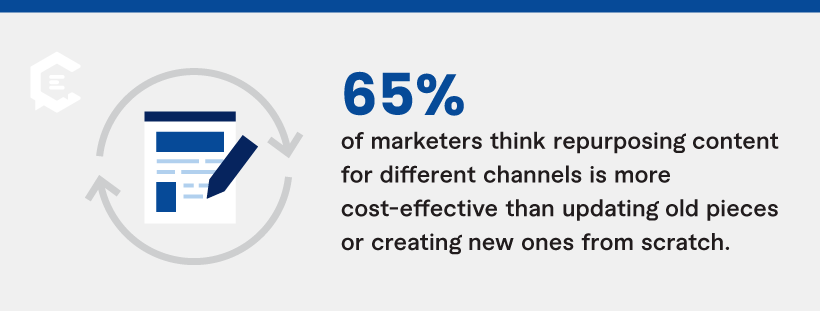Marketers love to say they “repurpose” content. In fact, 94 percent of marketers repurpose in some way. But too often that means copy and paste. A blog post becomes a LinkedIn post word-for-word, or a webinar is uploaded to YouTube without edits.
The problem? That kind of content adaptation misses the point. It ignores how people actually search, scroll, or watch.
In this guide, we’ll show why copy-pasting is a trap and share best practices for a smart content repurposing strategy. You’ll see why each channel needs its own approach, how to match content to the funnel, and how to build a framework you can actually repeat and scale.

The Problem with “Copy-Paste” Repurposing
Every channel has its own ecosystem: tone, cadence, and consumption habits. When teams republish content as is, they risk:
Losing relevance
Audiences know when content isn’t made for them. Drop a 1,500-word blog post on LinkedIn, and it feels out of place. Upload a webinar to YouTube without edits, and it drags. When content doesn’t fit the channel, people disengage. Repurposing only works when the content feels like it belongs.
Lower engagement
Posts that aren’t tailored to the platform rarely get traction. Algorithms are built to surface content that performs well natively. LinkedIn favors conversation, while YouTube favors watch time. Copy-paste posts don’t stand a chance.
Diluted brand voice
When content adaptation feels generic, it weakens credibility. If every piece sounds the same no matter the channel, the brand comes across as disconnected rather than intentional.
Matching Funnel Stage to Channel
The most effective multichannel content marketing aligns each format with its funnel role: top-of-funnel (ToFu) content, middle-of-funnel (MoFu) content, or bottom-of-funnel (BoFu) content.
When each channel serves a clear purpose, prospects get the right message at the right moment. This way, your content isn’t scattered across platforms. Instead, it guides people forward in their decision-making journey without losing relevance.
Blogs (ToFu + MoFu)
Blogs shine at the top and middle of the funnel because they capture search intent. They’re where buyers go first to ask questions, compare options, and look for expertise. Well-structured posts earn trust, get found in search, and answer “how” and “why” questions that draw readers in.
Repurposing blogs into different formats
Blogs can also act as anchors for other formats. A blog on “best content repurposing strategies” can start as a long-form piece for search. Parts of it might become a LinkedIn post that sparks discussion, a short video clip for YouTube or TikTok, and even a one-pager for sales. Same core idea, shaped to fit each channel.
LinkedIn (thought leadership + social proof)
Forty percent of B2B marketers rank LinkedIn as their most effective channel for high-quality leads. Buyers come here to see if a brand is credible and if others trust it.
LinkedIn posts work best when they feel real and trustworthy. Sharing genuine experiences, highlighting customer wins, and inviting conversation all signal authenticity. And authenticity builds trust.
From blog to LinkedIn post
A blog on “how AI saves time in customer support” could be reshaped into a short LinkedIn post that highlights a client who cut response times by 40 percent while boosting satisfaction. End with a simple question to kick off engagement, and the same idea now works as social proof and a conversation starter.
YouTube (MoFu demos + how-tos)
Video is especially powerful in the middle of the funnel, when prospects want to see solutions in action. It offers a level of validation text alone can’t match.
From blog to video demo
A blog on “adapting content for video” could transform into a three-minute screen-share walkthrough that demonstrates the process step by step. The same idea, shown visually, builds trust faster and helps shorten the path to conversion.
Decision-stage assets (BoFu)
Bottom-of-funnel content supports prospects who are ready to buy but need reassurance. Comparison pages, one-pagers, detailed case studies, and sales enablement materials help justify the purchase, overcome objections, and provide proof of results.
From blog to sales asset
A single blog idea could be distilled into a one-page “why us vs. them” sheet or a customer story formatted for a sales deck — the kind of content adaptation that gives buyers confidence and helps close the deal.
Adapting Core Ideas Across Channels
According to 65% of marketers, repurposing content for different channels is more cost-effective than updating old pieces (33%) or creating new ones from scratch (2%). That’s because true repurposing isn’t about saving effort; it’s about adapting smarter.
The secret of a successful content repurposing strategy is extracting themes, not text. And it’s worth repeating: The same core message can work across search, social, and video — but only when it’s reshaped to match funnel stage, audience behavior, and the platform. This is the foundation of effective multichannel content marketing.
Instead of copying sentences from one format and pasting them into another, marketers should:
- Reformat for length: Blog posts often run 1,000+ words. LinkedIn posts tend to perform best when kept concise, while YouTube intros need to hook viewers in the first 10–15 seconds. Each format demands a different level of detail and pacing.
- Adjust tone: Search content leans educational, social content leans conversational, and video content leans demonstrative. A message that works in one channel may not connect in another if the tone isn’t recalibrated.
- Match consumption habits: Readers skim blogs for subheads, social users prefer concise updates that can be read on the go, and video watchers expect visuals that keep their attention.
For example, one core idea — “content repurposing isn’t copy-paste” — could be executed three ways:
- Blog: a long-form post analyzing pitfalls and offering solutions.
- LinkedIn: a short post opening with, “If you’re still CTRL+C and CTRL+V-ing your content, you don’t have a repurposing strategy. You have duplication.”
- YouTube: A three-minute explainer contrasting copy-paste versus adapted repurposing, complete with screen shares.
Same idea, three formats, each reshaped for its audience.
The Role of Specialized Teams in Repurposing
Even inside larger organizations, content teams are often lean. Marketers end up wearing multiple hats, stretching across blogs, social, video, and strategy. That’s when repurposing slips into copy-paste instead of the adaptation it’s meant to be.
But your content repurposing strategy will work best when specialists shape ideas for their platforms, adding the depth and nuance that generic execution can’t match. For instance:
- SEO writers know how to structure posts for keywords, snippets, and dwell time. They understand search intent and how to organize long-form content so it ranks and keeps readers engaged.
- Social strategists understand what sparks conversation, shares, and saves. They can repurpose ideas for social media into concise posts, pick the right hooks, and encourage interaction instead of just impressions.
- Video editors know how to keep attention in the first 15 seconds. They can design intros that hook viewers, edit for pacing, and highlight visuals that reinforce the message.
A head of content, or a content strategist, ties it all together. Their job is to keep your multichannel content marketing engine moving in the same direction instead of drifting into silos. With the right orchestration, one core idea doesn’t just get repurposed; it builds momentum across search, social, and video.
Building a Content Adaptation Framework
Your content repurposing strategy will be most effective when it’s built into your content process, not tacked on at the end. A clear framework turns one-off experiments into a repeatable process that scales.
Marketers can operationalize repurposing by:
- Starting with the core asset: Anchor the strategy around a substantial piece of content, like a research-backed blog post, customer interview, or webinar. This becomes the foundation for multiple spin-offs.
- Identifying derivative formats: Map out in advance how the core idea can be reshaped, whether that’s a series of social posts, an infographic, a short-form video, or a one-pager for sales enablement.
- Assigning channel owners: Give responsibility to the people who know the platform best: SEO writers for blogs, social strategists for LinkedIn, or video editors for YouTube. Clear ownership prevents watered-down, one-size-fits-all execution.
- Creating feedback loops: Share insights across teams. If a LinkedIn post drives unexpected engagement, those learnings can refine your blog strategy. If a YouTube video underperforms, the data can guide future messaging.
- Aligning across teams: Repurposing is most effective when SEO, social, video, and sales teams work from the same playbook. When channels complement each other instead of competing, every piece of content adds to the bigger impact.
Repurposing as a Growth Multiplier
When done right, content repurposing extends the life of core ideas far beyond their first publish date. Instead of fading after launch, content keeps working across channels, reaching audiences in the formats they prefer, and delivering more value from every campaign.
Ready to put this into practice? Connect with a ClearVoice strategist today to access SEO writers, social strategists, and video experts who know how to adapt ideas for every stage of the funnel.
Build a content repurposing strategy that scales, and make your content go further.





